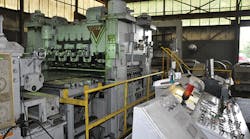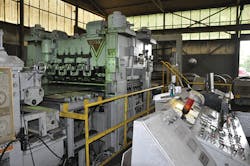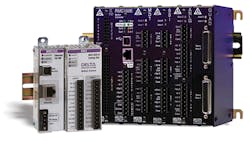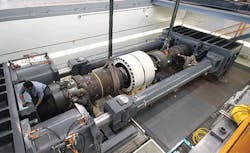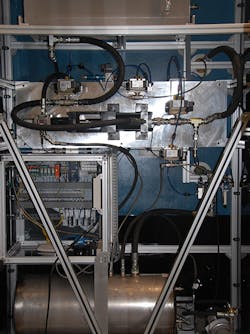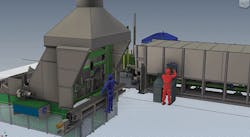This file type includes high-resolution graphics and schematics when applicable.
Motion controllers are among the most ubiquitous electronic system elements used in today’s factories and laboratory environments. The latest motion controllers can synchronize multiple motion axes, control both position and pressure/force being applied, and interface easily to other system elements to enhance the capabilities of a production machine or test system.
Retrofitting Obsolete Control Systems
A major trend currently pervading machine design is the use of best-in-class motion controllers to retrofit older machines in order to increase productivity and maintainability of the work cell. Older machines often contain worn and obsolete control elements, causing product quality to suffer and making the machines difficult and expensive to maintain.
At the same time, the latest controllers generally offer capabilities not available with the older varieties. Since a machine’s mechanical components may still be serviceable, simply replacing the controller can give an older machine renewed value, let alone the capabilities of a new machine, at much lower cost.
Faster processors in the new controllers allow for closed loop times in the microsecond and millisecond range compared to slower loops in older controllers, and can bring flexibility, accuracy, precision, and speed to machine operation. With the major hardware elements in older machines being reused, control upgrades typically require only a new controller, new sensors, and more precise actuators (drives or hydraulic valves).
Higher-end controllers augment proportional (P) gain with integral (I) and derivative (D) gain terms, which respond, respectively, to reduce errors that would build over time, or to errors that would build very quickly. Some new controllers employ predictive gains in the control-loop equation called feed forwards, which act to contribute to the controller output during the required position movement or force profile.
The combination of P, I and D terms and feed-forward terms are all available for adjustment when tuning the control algorithm. Feed forwards refer to the parameters that are separate from the P, I, and D terms. P, I, and D act on the feedback signal coming from the transducers, and as such, the action of these terms follow the action of the system. Once set, the controller operates a servo-quality proportional valve to cause the motion to go to the target positions using precise velocities, accelerations, and decelerations. The programmable acceleration and deceleration parameters help produce smooth motion and reduce wear and tear on the system.
In the case of presses, one can ramp down the velocity of the appropriate axes. Therefore, when the tooling makes contact with the work piece, the press will have just the right amount of kinetic energy to do the necessary work—without causing excessive shock or vibration.
An example of a control system retrofit that improved machine productivity was recently executed by Hagerty Steel, East Peoria, Ill. Hagerty added a new control system for its heavy-gauge steel coil cut-to-length line; it had been upgraded three times previously over the years, but was still not cutting sheets precisely. “One of our customers requested that we tighten our tolerance, and with the old system it was impossible,” says Thomas Boon, Hagerty Steel Maintenance Manager.
To fix the problem, they needed an electronic motion controller that could perform complex multi-axis synchronization tasks. Based on experience with an upgrade of another machine at the Hagerty plant, Delta Computer Systems’ RMC150 eight-axis motion controller was deemed the best choice. The controller has several built-in multi-axis gearing, camming, and synchronization functions that enable multiple slave motion axes (in this case, controlling multiple different-sized roller drive motors) to produce tightly controlled motion in relation to that of a master axis.
Hagerty’s controller upgrade did resolve the production quality issues. “Whereas the old machine was only able to produce steel sheets to within tolerances of approximately ±1/4 inch, and out-of-tolerance material was wasted, we were ultimately able to tune the machine to achieve the required dimension to within 1/1000 of an inch,” says Glenn McIntyre, Controls Engineering Manager at systems engineering firm Advanced System Integration & Control Inc. (ASIC), West Chester, Ohio. “And we were able to get the system to settle down quickly so our customer could fire the shear more quickly and increase their production rate.”
Augmenting PCs in New Testing Applications
Old “stress it until it breaks” test platforms are being replaced by smart test platforms that exercise a product in a manner that’s very similar to real-world conditions in the field. Such systems can gather data on product performance to profile wear-out conditions before the product breaks. The PC computing platform is often the nexus for the development of testing and instrumentation software, but the PC by itself is not reliable enough to control test hardware that depends on real-time application for stimulus to the device under test.
Test engineers and designers in R&D labs are increasingly using motion controllers to add new capabilities to augment the functionality and performance improvements delivered by the evolving PC architecture. Tightly coupling a PC with a motion controller can leverage the wealth of PC instrumentation and data-acquisition software; while at the same time apply test stresses in a precise manner to a device under test.
An example of such a system is Dril-Quip’s (Houston, Texas) test platform for subsea oil pipe connectors. Applying large forces, like those required to place bending forces on pipe assemblies similar to that shown in the figure above, is the domain of the largest of hydraulic rams. Controlling them requires an electrohydraulic motion controller with special capabilities for closed-loop force control.
In the Dril-Quip test system, the RMC150 receives commands over an Ethernet link from a LabWindows/CVI program running on the PC. These commands provide instructions to the motion controller on how to move the hydraulic cylinders and at what pressure. A software package supplied by Delta facilitates the connection between the motion controller and PC software applications, which allows the PC to send and receive data from the motion controller over Ethernet.
The motion controller reads the differential hydraulic pressure across the piston of each cylinder in order to calculate and control the force being applied to the specimen. The controller uses position feedback from magnetostrictive displacement transducers (MDTs), mounted between the cylinder housing and the cylinder rod, to measure the deflection of the specimen. A multi-axis controller can simultaneously control a different motion profile for each axis.
To complete the instrumentation of the system, strain gauges mount directly onto the specimen at specific places and send the strain signal to the LabWindows/CVI Strain Gauge module in the chassis. Pressure and temperature transducers mount on various parts of the test fixture and connect to another LabWindows/CVI data acquisition chassis. The transducer signals are converted to engineering units inside of the LabWindows/CVI program. Process status, parameter values, and limit warnings are updated on operator screens attached to the PC.
With the new test system, Dril-Quip is able to simulate field conditions with load, bending, and internal pressure that would otherwise be impossible in a lab setting using PC software alone. The system has given Dril-Quip an increased understanding of wellhead performance, and the knowledge to increase their customers’ confidence in the Dril-Quip’s subsea wellhead system.
Controllers Controlling No Motion
It may sound strange at first to discuss using a motion controller for an application that does not involve actual movement of a machine axis, but consider the fact that motion controllers excel at closed-loop control. Sometimes the parameter being controlled is something other than the position of a mechanical axis; for example, the pressure of a fluid. An automotive test system manufactured by Innkeeper LLC, Livonia, Mich., embodies one such example.
As with Dril-Quip in the previous section, Innkeeper bases its automotive test controls on two key elements: an electro-hydraulic motion controller to deliver real-world stresses, and a PC with a standardized user interface, which in this case can be used to set up and control a wide range of automotive testing applications and gather test data.
One application developed by Innkeeper tests heat exchangers used in transmission coolers. The system uses a servo hydraulic cylinder acting like a syringe to inject high-frequency pressure pulses into the test specimen. In this manner, the machine can accurately reproduce the pressure fluctuations that occur under actual vehicle conditions. The cylinder is operated via a high-performance servo valve, which is in turn driven by the motion controller.
Different Innkeeper test systems use RMC75 (1-2 axes) or RMC151 (2-8 axes) motion controllers, which connect to the PC via Ethernet and perform all of the closed-loop control, limit checking, and cycle counting. The controller holds the custom test profiles, allowing the PC to stay out of the loop and focus on monitoring/acquiring data.
The “series controllers provide us with great control on all tests ranging from quasi-static through 50-Hz operation, with a loop update rate between 1000-4000 Hz and supporting data acquisition of all signals up to 1000 samples per second per channel,” says Kevin Kretschmann, Innkeeper principal. “We can build and the accurately control any waveform or combination of waves within this range.”
Save Energy, Support the Connected Enterprise
To improve productivity, new machines are typically network-enabled by sharing process data between subsystems, as well as sharing production information with the enterprise. Even with older machines, machine builders can cut hardware costs and make it easier to maintain and expand their systems by replacing outdated, discretely connected motion elements with network-enabled versions.
For example, productivity can be increased in many metal-forming applications by joining work cells together and streamlining the output from one stage into the next. Proof of this can be found at Dayton Parts, Harrisburg, Pa., a manufacturer of formed metal products for the vehicle after-market. The company's leaf-spring manufacturing process, which was part of a manufacturing operation dating back to the 1920s, was upgraded this past year to automate the punching process and connect the punching and forming processes into a smooth flow.
Achieving fast cycle times for the combined machine requires precise control and close communications between the motion operations performed in the process stages. Supervisory control is performed by a PLC, but control of the individual motion axes required programmable motion controllers with special capabilities for multi-axis coordination. Dayton Parts’ engineers chose the RMC150 and RMC75 motion controllers.
The combined Dayton Parts punching and forming work cell exemplifies how machine-to-machine (M2M) communications can improve a process. The supervisory PLC connects via Ethernet interfaces to the two motion controllers, multiple HMI terminals, and a series of I/O racks. Communicating via the networks, the PLC adjusts the cycle time of the furnace and sets the speed of subsequent stages in the line. For maximum productivity, and to ensure that heat transfer from the hot parts passing through the system does not affect sensitive system components, it is critical that the process proceeds as smoothly and expediently as possible.
The local machine network also connects to the factory LAN so that production information is available to corporate SPC and quality analysis software. This can help optimize performance and identify maintenance issues for resolution before they become a problem.
The PLC is connected to a Microsoft Access database containing the manufacturing parameters of all leaf springs made by Dayton Parts. The operator selects to make the next leaf spring via a touchscreen interface, and the PLC downloads the appropriate process parameters to the temperature/pressure controllers, and motion sequences to the motion controllers.
“The system automatically processes via recipe to speed production changeovers and gain repeatability, which we didn’t have before,” says Greg Shortridge, Dayton Parts electrical engineer. “We often have relatively small production runs where a spring may contain up to 12 different leaves. In the old days, we would have to manually dial in new furnace temperatures, forming pressures, and quench timer settings when we would change parts to be manufactured, which was time-consuming and could introduce errors and downtime that we can’t afford.”
The updated line has minimized reheat and changeover downtime, as well as cut cycle times down to 17 seconds per part. “We’re seeing 95% combined uptime for the machines,” says Joe Garcia, Dayton Parts Project Manager. “And the material-handling and energy savings for the company were sufficiently large to pay for this project in one year.”
The applications described in this article highlight how today’s modern motion controllers extend machine life, save time, reduce energy consumption, increase production, and improve quality. Any application in which closed-loop control can deliver smoother or more precise process operation is a likely candidate for using a motion controller.
